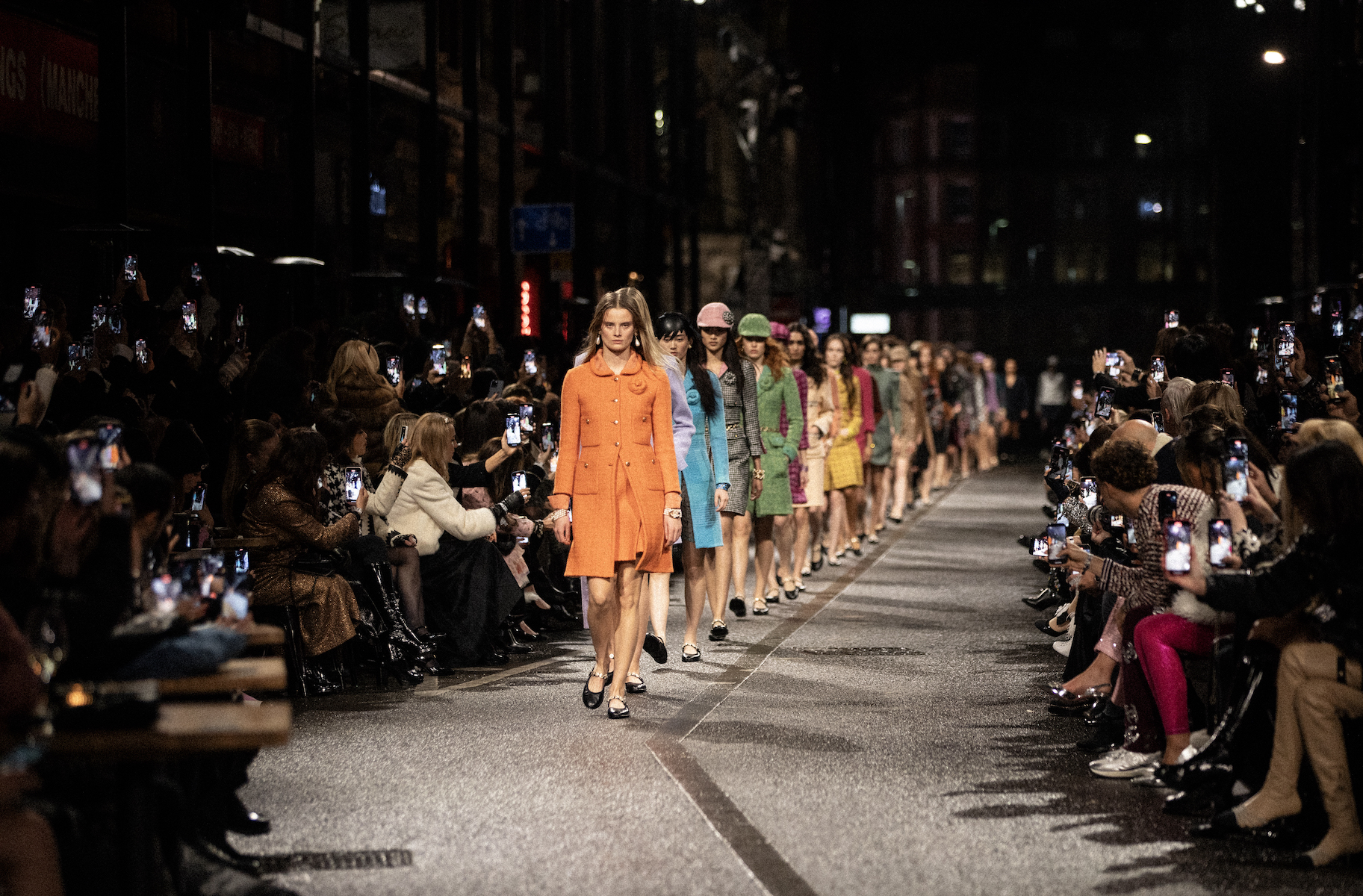
Seminal British graphic designer Peter Saville returned to the medium with which he is perhaps most synonymous, the record sleeve, creating the invitation for Chanel’s blockbuster Métiers d’art show held in Manchester yesterday evening (7 December 2023). Inside, a four-track record ‘curated’ by longtime Chanel collaborator Michel Gaubert, featured songs from the city’s native musicians, from New Order to The Fall.
‘I had never thought that one day I would curate a compilation about Manchester for Chanel, with Peter Saville creating the artwork for it,’ said the French sound engineer, who revealed the dotted cover sleeve – which reads ‘Chanel MCR’ – on Instagram just before the show’s start. ‘But here it is.’
Chanel arrives in Manchester for Métiers d’art show
Indeed, Gaubert’s surprise echoed much of the conversation in the run-up to the show. Coronation Street, football, Brit pop: Manchester’s cultural exports initially seemed incongruous with the vaunted refinement of Chanel, whose previous Métiers d’art shows have taken place in an Austrian palace, the Ritz Hotel in Paris, and the Fellini-favoured Cinecittà Studios in Rome, among other dramatic backdrops. Even the last Métiers d’art show held in the UK back in 2012 took place at Scotland’s 15th-century Linlithgow Palace, the 15th-century seat of the Stuarts.
But Viard – who took over creative direction of the house in the wake of Karl Lagerfeld’s death in 2019 – has instilled the house a lighter, more youthful energy, which largely returns to the liberated spirit of house founder Gabrielle ‘Coco’ Chanel for inspiration. Here, she said that she was inspired not only by the house founder’s longtime links to the locale – nicknamed ‘Cottonopolis’, Manchester’s vast industrial factories were some of the foremost fabric producers, which Chanel used in her collections – but also the energy of the city’s music scene.
‘For me, Manchester is the city of music,’ said the designer. ‘It incites to creation.’
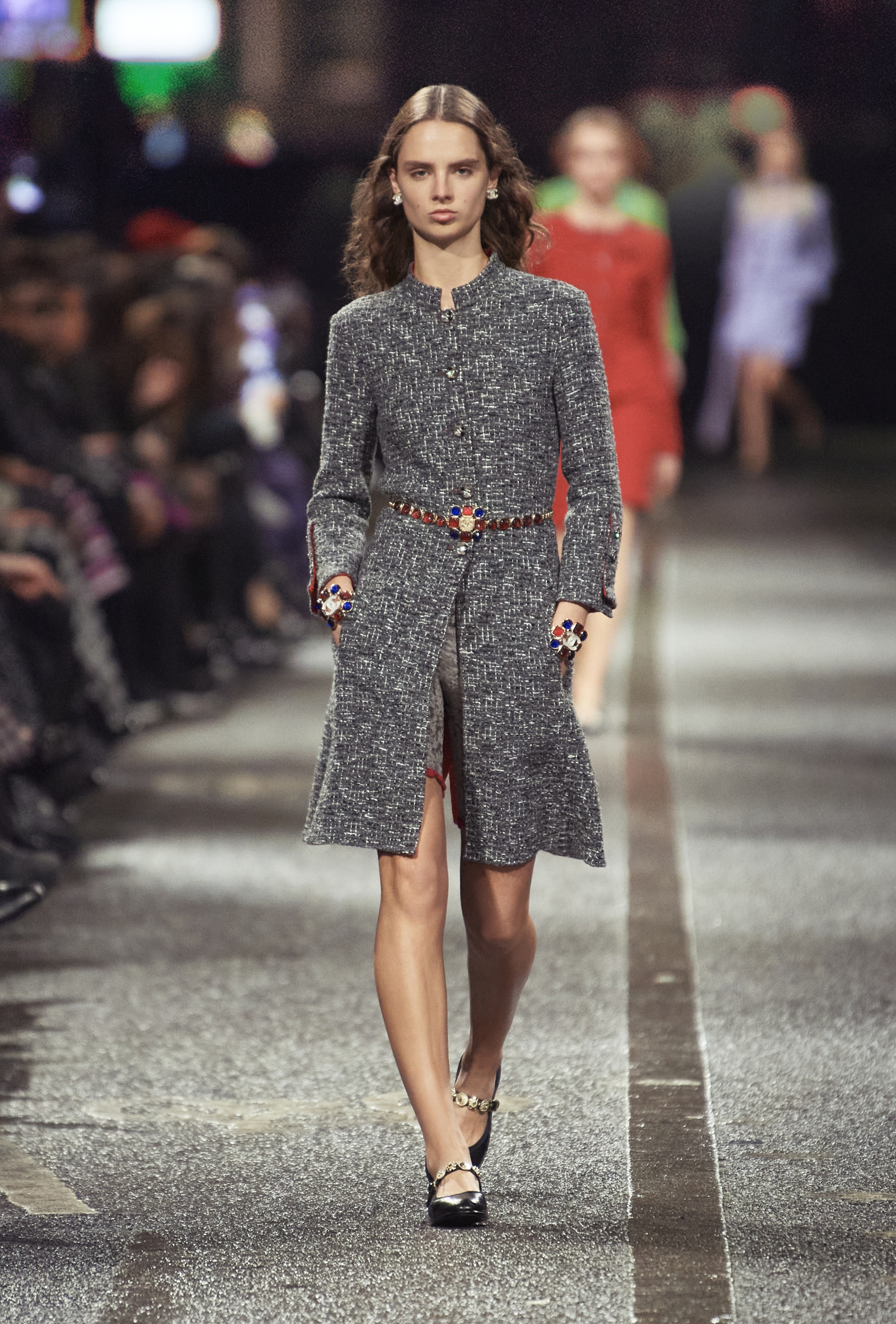
It made Saville a fitting choice. Born in Manchester in 1955 – and going on to study at the city’s polytechnic college – he would work closely with Factory Records, the Tony Wilson-led label that imprinted some of the era’s most influential bands, among them Joy Division, New Order, A Certain Ratio and the Happy Mondays. Originally centred around the now-demolished Russell Club in Manchester’s industrial Hulme district – it would become better known as ‘The Factory’ – Saville would create the flyers for its club nights, and later the record sleeves for its most famous releases.
Perhaps most memorably, he worked on the cover art for Joy Division’s 1979 record Unknown Pleasures, which featured a 1919 image of the first pulsar waves, taken from the Cambridge Encyclopedia of Astronomy. Describing its design to The Guardian newspaper in 2011, he said it was at once ‘technical and sensual’, which is an apt descriptor for Saville’s own output, defined by a sparse but nonetheless evocative style. ‘It was the post-punk moment and we were against overblown stardom. The band didn’t want to be pop stars.’
Viard seemed to echo this sensibility in the collection, which she described as one of ‘utmost simplicity and precision’, nonetheless infused with a ‘vibrant, pop spirit’. The latter she said came from Coco Chanel’s use of colour in her famed tweed suits, here recreated in numerous iterations, which seemed to recall the 1960s in their nipped and abbreviated silhouettes. These looks were completed with baker boy hats (also in tweed), camellia-flower rosettes, and stitched or ruffled trims.
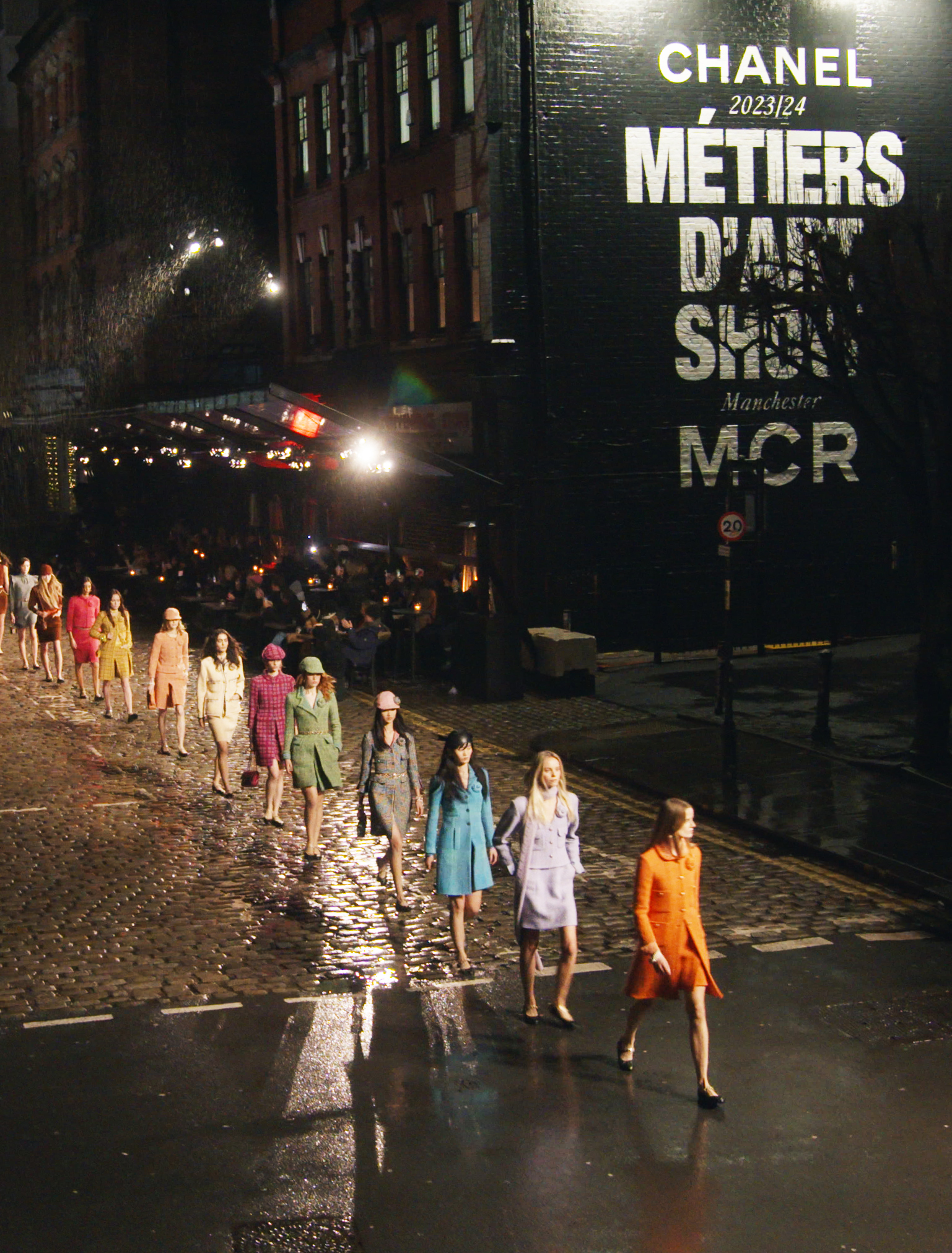
’Tweed is central to this collection,’ said Viard. ‘I thought a lot about Gabrielle Chanel but I didn’t want to recreate Coco’s look, when she was wearing the Duke of Westminster’s jackets. I took my cue from the Coco who brought colour to her tweeds.’
Elsewhere, there were girlish shift dresses, caped knitwear (cut for the freedom of movement Viard said she desired in the pieces), and bermuda shorts. Expressions of craft – the purpose of the yearly Métiers d’art show is to celebrate the artisanal technique of the house‘s various métiers – appeared throughout, from feather work to intricate pearl adornment.
The show – which shut down Manchester’s buzzing Northern Quarter – comes at something of a renaissance for the city, which recently saw the opening of a vast new cultural venue Aviva Studios – Factory International. Designed by OMA, the space – which Wallpaper* architecture editor Ellie Stathaki described as a ‘moveable feast’ for its modular design – will host theatre events, art exhibitions, and an array of other performances.
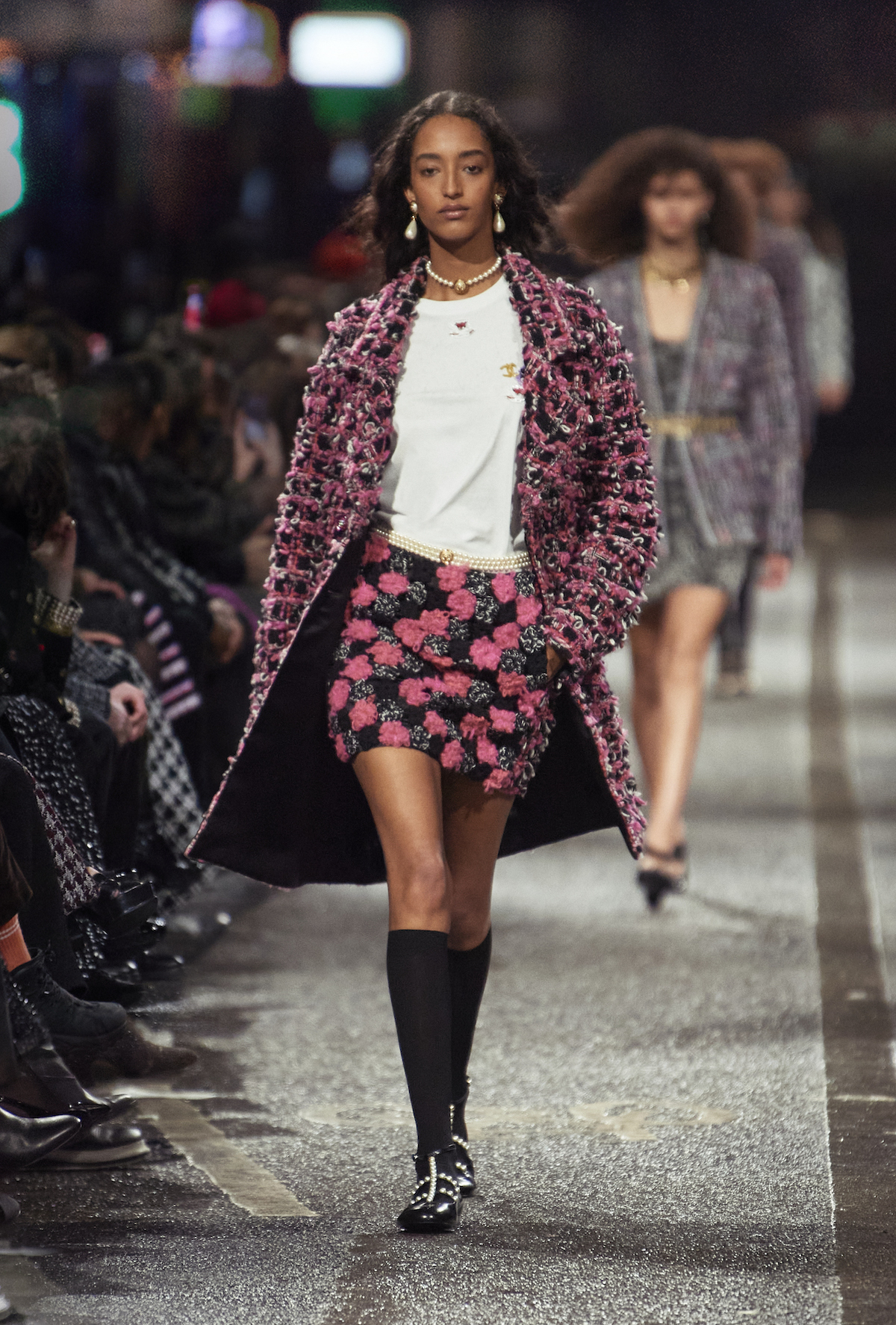
‘The most important thing for me is that this is a building for the next generation, a building that gives people a place to try new things, not to conform to what you should do – a testing ground, an incubator,’ said Ellen van Loon, the OMA partner in charge of the project, earlier this year, a hopeful mood which Chanel echoed.
‘Too many things happen in London and we wanted to be in the UK out of London,’ said Bruno Pavlovsky, Chanel’s president. ‘We decided to come to Manchester because it was the most inspiring for Virginie. She was inspired by the music and art that she sees here in Manchester, and we've had a warm welcome.’
Saville was also recruited to take part in the Factory International project, working alongside design studio North on the space’s visual identity. Taking inspiration from the original Factory Records logo, the design is meant to have ‘a machine-like functionality’, says North.
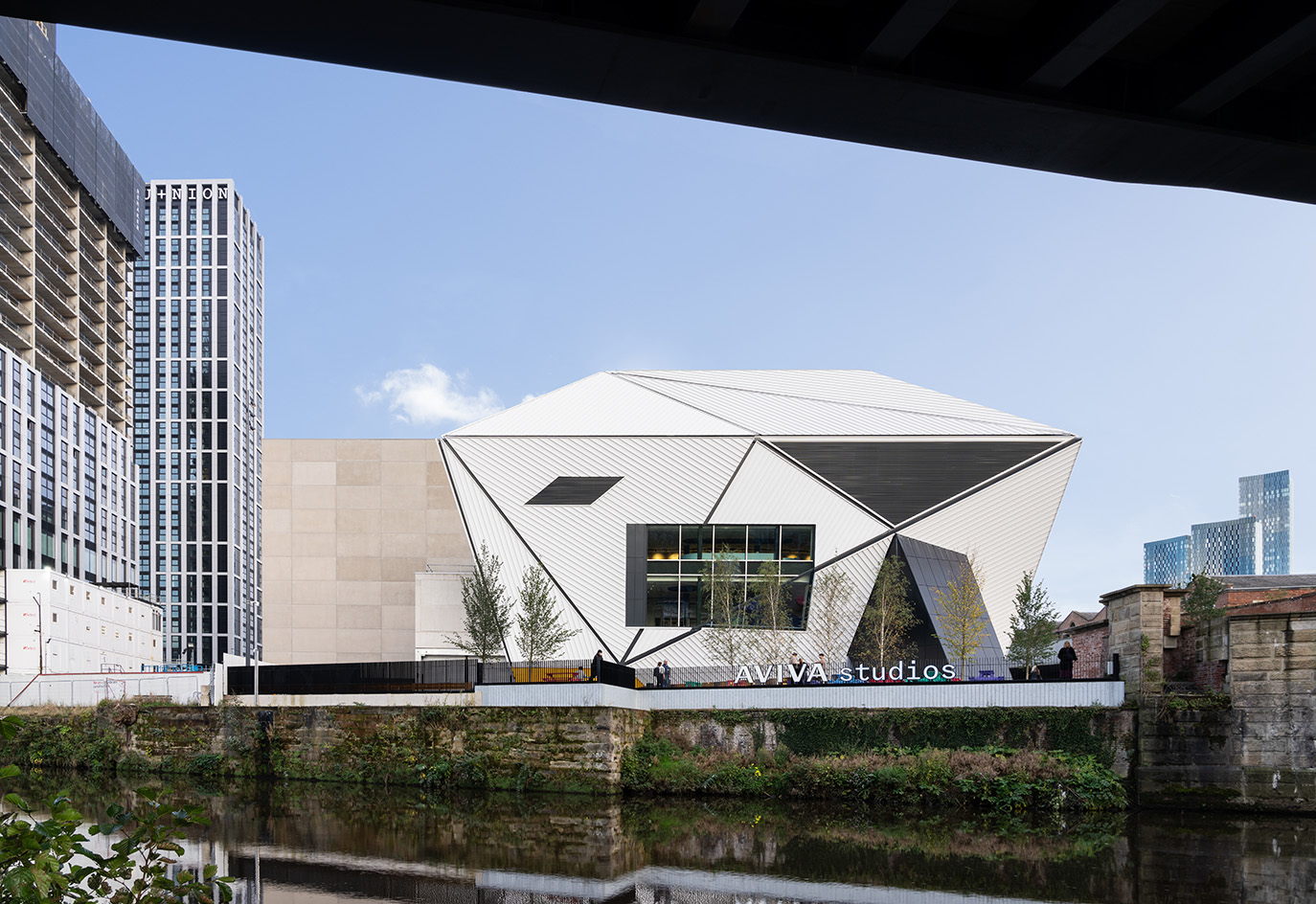
‘I see Factory International, and its new home, as a two-way portal between Manchester and the world, through the broadest medium of the arts,’ said Saville at the time. ’The world comes in through it and Manchester goes out through it. It is itself a signifier of intent and ambition, so it’s inspiring.’







